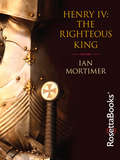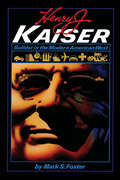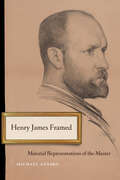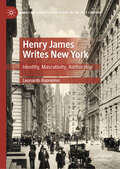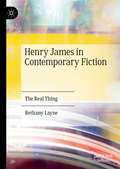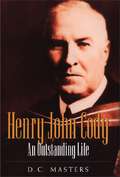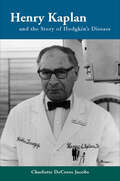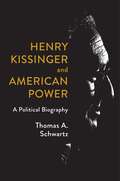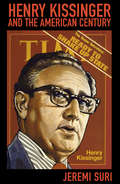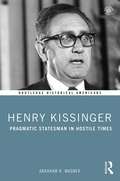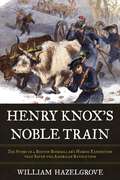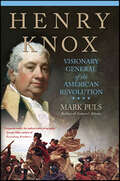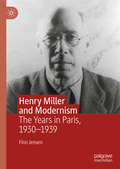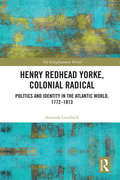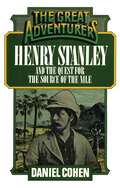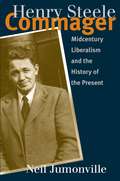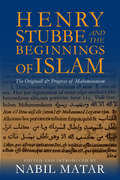- Table View
- List View
Henry IV: The Righteous King
by Ian MortimerThe real life story of the Plantagenet ruler, by &“the most remarkable medieval historian of our time&” (The Times, London). The talented, confident, and intelligent son of John of Gaunt, Henry IV started his reign as a popular and charismatic king after he dethroned the tyrannical and wildly unpopular Richard II. But six years into his reign, Henry had survived eight assassination and overthrow attempts. Having broken God&’s law of primogeniture by overthrowing the man many people saw as the chosen king, Henry IV left himself vulnerable to challenges from powerful enemies about the validity of his reign. Even so, Henry managed to establish the new Lancastrian dynasty and a new rule of law—in highly turbulent times. In this book, noted historian Ian Mortimer, bestselling author of The Time Traveler&’s Guide to Medieval England and The Time Traveler&’s Guide to Elizabethan England, goes beyond the legend portrayed in Shakespeare&’s history play, and explores the political and social forces that transformed Henry IV from his nation&’s savior to its scourge.
Henry Irving: A Re-Evaluation of the Pre-Eminent Victorian Actor-Manager (Routledge Library Editions: The Victorian World #18)
by Richard FoulkesHenry Irving (1838-1905), the first actor to be knighted, dominated the theatre in Britain and beyond for over a quarter of a century. As an actor, he was strikingly different with his idiosyncratic pronunciation, his somewhat ungainly physique, and his brilliant psychological portrayals of virtue and villainy. He was also the director of spectacular, and commercially driven, entertainments and as the manager of the Lyceum theatre, he controlled every aspect of the performance. First published in 2008, this collection of essays by leading theatre scholars explores each element of Irving’s art: his acting, his contribution to the plays he commissioned, his flair for the stage picture, and his ear for incidental music. This book will be of interest to those studying the history of theatre.
Henry J. Kaiser: Builder in the Modern American West
by Mark S. Foster&“His standing as a lesser-known in a business pantheon that would include such names as Ford and Carnegie makes this work of some scholarly importance.&” —Library Journal In the 1940s Henry J. Kaiser was a household name, as familiar then as Warren Buffett and Donald Trump are now. Like a Horatio Alger hero, Kaiser rose from lower-middle-class origins to become an enormously wealthy entrepreneur, building roads, bridges, dams, and housing. He established giant businesses in cement, aluminum, chemicals, steel, health care, and tourism. During World War II, his companies built cargo planes and Liberty ships. After the war, he manufactured the Kaiser-Frazer automobile. Along the way, he also became a major force in the development of the western United States, including Hawaii. Henry J. Kaiser: Builder in the Modern American West is the first biography of this remarkable man. Drawing on a wealth of archival material never before utilized, Mark Foster covers Kaiser&’s entire life (1882–1967), painting an evenhanded portrait of a man of driving ambition and integrity, demonstrating Kaiser as the prototypical &“frontier&” entrepreneur who often used government and union support to tame the &“wilderness.&” Today the Kaiser legacy remains great. Kaiser played a major role in building the Hoover, Bonneville, Grand Coulee, and Shasta dams. The Kaiser-Permanente Medical Care Program still provides comprehensive health care for millions of subscribers. Kaiser-planned communities remain in Los Angeles; San Francisco; Portland, Oregon; and Boulder City, Nevada. Kaiser Engineers was actively engaged in hundreds of huge construction jobs across the nation and around the world. US and business historians, scholars of the modern West, and general readers will find much to absorb in this well-written biography.
Henry James Framed: Material Representations of the Master
by Michael AneskoHenry James Framed is a cultural history of Henry James as a work of art. Throughout his life, James demonstrated an abiding interest in—some would say an obsession with—the visual arts. In his most influential testaments about the art of fiction, James frequently invoked a deeply felt analogy between imaginative writing and painting. At a time when having a photographic carte de visite was an expected social commonplace, James detested the necessity of replenishing his supply or of distributing his autographed image to well-wishing friends and imploring readers. Yet for a man who set the highest premium on personal privacy, James seems to have had few reservations about serving as a model for artists in other media and sat for his portrait a remarkable number of twenty-four times. Surprisingly few James scholars have brought into primary focus those occasions when the author was not writing about art but instead became art himself, through the creative expression of another&’s talent. To better understand the twenty-four occasions he sat for others to represent him, Michael Anesko reconstructs the specific contexts for these works&’ coming into being, assesses James&’s relationships with his artists and patrons, documents his judgments concerning the objects produced, and, insofar as possible, traces the later provenance of each of them. James&’s long-established intimacy with the studio world deepened his understanding of the complex relationship between the artist and his sitter. James insisted above all that a portrait was a revelation of two realities: the man whom it was the artist&’s conscious effort to reveal and the artist, or interpreter, expressed in the very quality and temper of that effort. The product offered a double vision—the strongest dose of life that art could give, and the strongest dose of art that life could give.
Henry James Writes New York: Identity, Masculinity, Authorship (American Literature Readings in the 21st Century)
by Leonardo BuonomoThis book offers the first full-length study of Henry James's relationship with, and literary treatment of, New York. It shows how the city, whether observed or reimagined, always remained an essential component of James's identity. New York compelled James to confront both his status as an American-born male artist and his age's prevailing notions of gender, sexuality, class, citizenship, and success. Tracing James's attachment to the city and how it evolved during his lifetime, this book examines a wide range of James's works, from his short stories and novels to his non-fiction writing.
Henry James in Contemporary Fiction: The Real Thing
by Bethany LayneThis book explores the extraordinary proliferation of novels based on Henry James’s life and works published between 2001 and 2016, the centenary of his death. Part One concentrates on biofictions about James by David Lodge and Colm Tóibín, and those written from the perspective of the key female figures in his life. Part Two explores appropriations of The Portrait of a Lady, The Turn of the Screw, and The Ambassadors. The book articulates the developments in biographical and adaptive writing that enabled millennial writers to engage so explicitly with James, locates the sources of his appeal, and explores the different forms of engagement taken. Layne analyses how these manifestations of James’s legacy might function differently for knowing versus unknowing readers, and how they might perform the role of literary criticism. Overarching themes include ideas of queering, the concern with seeking redress, and the frustrated quest for origin, authenticity, or ‘the real thing’.
Henry James in Context
by David McwhirterLong misread as a novelist conspicuously lacking in historical consciousness, Henry James has often been viewed as detached from, and uninterested in, the social, political, and material realities of his time. As this volume demonstrates, however, James was acutely responsive not only to his era's changing attitudes toward gender, sexuality, class, and ethnicity, but also to changing conditions of literary production and reception, the rise of consumerism and mass culture, and the emergence of new technologies and media, of new apprehensions of time and space. These essays portray the author and his works in the context of the modernity that determined, formed, interested, appalled, and/or provoked his always curious mind. With contributions from an international cast of distinguished scholars, Henry James in Context provides a map of leading edge work in contemporary James studies, an invaluable reference work for students and scholars, and a blueprint for possible future directions.
Henry John Cody: An Outstanding Life
by Donald Campbell MastersHenry John Cody was born in Embro, Ontario, on December 6, 1868. He was a great man in his day, in Toronto especially, in the Anglican church, in educational circles (both in school and university), and in the Conservative Party, but now, some forty years after his death, he is almost forgotten and indeed unheard of by anyone under 50.
Henry Kaplan and the Story of Hodgkin's Disease
by Charlotte JacobsIn the 1950s, ninety-five percent of patients with Hodgkin's disease, a cancer of lymph tissue which afflicts young adults, died. Today most are cured, due mainly to the efforts of Dr. Henry Kaplan. Henry Kaplan and the Story of Hodgkin's Disease explores the life of this multifaceted, internationally known radiation oncologist, called a "saint" by some, a "malignant son of a bitch" by others. Kaplan's passion to cure cancer dominated his life and helped him weather the controversy that marked each of his innovations, but it extracted a high price, leaving casualties along the way. Most never knew of his family struggles, his ill-fated love affair with Stanford University, or the humanitarian efforts that imperiled him. Today, Kaplan ranks as one of the foremost physician-scientists in the history of cancer medicine. In this book Charlotte Jacobs gives us the first account of a remarkable man who changed the face of cancer therapy and the history of a once fatal, now curable, cancer. She presents a dual drama --the biography of this renowned man who called cancer his "Moby Dick" and the history of Hodgkin's disease, the malignancy he set out to annihilate. The book recounts the history of Hodgkin's disease, first described in 1832: the key figures, the serendipitous discoveries of radiation and chemotherapy, the improving cure rates, the unanticipated toxicities. The lives of individual patients, bold enough to undergo experimental therapies, lend poignancy to the successes and failures. Visit the author's website.
Henry Kissinger and American Power: A Political Biography
by Thomas A. Schwartz[Henry Kissinger and American Power] effectively separates the man from the myths." —The Christian Science Monitor | Best books of August 2020The definitive biography of Henry Kissinger—at least for those who neither revere nor revile himOver the past six decades, Henry Kissinger has been America’s most consistently praised—and reviled—public figure. He was hailed as a “miracle worker” for his peacemaking in the Middle East, pursuit of détente with the Soviet Union, negotiation of an end to the Vietnam War, and secret plan to open the United States to China. He was assailed from the left and from the right for his indifference to human rights, complicity in the pointless sacrifice of American and Vietnamese lives, and reliance on deception and intrigue. Was he a brilliant master strategist—“the 20th century’s greatest 19th century statesman”—or a cold-blooded monster who eroded America’s moral standing for the sake of self-promotion?In this masterfully researched biography, the renowned diplomatic historian Thomas Schwartz offers an authoritative, and fair-minded, answer to this question. While other biographers have engaged in hagiography or demonology, Schwartz takes a measured view of his subject. He recognizes Kissinger’s successes and acknowledges that Kissinger thought seriously and with great insight about the foreign policy issues of his time, while also recognizing his failures, his penchant for backbiting, and his reliance on ingratiating and fawning praise of the president as a source of power. Throughout, Schwartz stresses Kissinger’s artful invention of himself as a celebrity diplomat and his domination of the medium of television news. He also notes Kissinger’s sensitivity to domestic and partisan politics, complicating—and undermining—the image of the far-seeing statesman who stands above the squabbles of popular strife. Rounded and textured, and rich with new insights into key dilemmas of American power, Henry Kissinger and American Power stands as an essential guide to a man whose legacy is as complex as the last sixty years of US history itself.
Henry Kissinger and the American Century: Global Revolution And The Rise Of Detente
by Jeremi SuriWhat made Henry Kissinger the kind of diplomat he was? What experiences and influences shaped his worldview and provided the framework for his approach to international relations? Jeremi Suri offers a thought-provoking, interpretive study of one of the most influential and controversial political figures of the twentieth century. Drawing on research in more than six countries in addition to extensive interviews with Kissinger and others, Suri analyzes the sources of Kissinger's ideas and power and explains why he pursued the policies he did. Kissinger's German-Jewish background, fears of democratic weakness, belief in the primacy of the relationship between the United States and Europe, and faith in the indispensable role America plays in the world shaped his career and his foreign policy. Suri shows how Kissinger's early years in Weimar and Nazi Germany, his experiences in the U. S. Army and at Harvard University, and his relationships with powerful patrons--including Nelson Rockefeller and Richard Nixon--shed new light on the policymaker. Kissinger's career was a product of the global changes that made the American Century. He remains influential because his ideas are rooted so deeply in dominant assumptions about the world. In treating Kissinger fairly and critically as a historical figure, without polemical judgments, Suri provides critical context for this important figure. He illuminates the legacies of Kissinger's policies for the United States in the twenty-first century.
Henry Kissinger: Pragmatic Statesman in Hostile Times (Routledge Historical Americans)
by Abraham R. WagnerHenry Kissinger: Pragmatic Statesman in Hostile Times explores the influence of statesman Henry Kissinger in American foreign relations and national security during 1969 to 1977. Henry Kissinger arrived in the U.S. as a young Jewish refugee and went on to serve as National Security Advisor and Secretary of State to Presidents Nixon and Ford. The consulting firm he founded has advised every U.S. president since. In this book, Abraham R. Wagner reveals how Kissinger used his knowledge of history and international relations to advocate a realpolitik approach to U.S. foreign policy. Through seven selected primary source documents, Wagner tracks how Kissinger became an iconic figure in international relations that polarized opinion during 1969 to 1977, a critical and controversial period of American history. This book will be useful for students interested in American history and security studies, especially those with an interest in U.S. international relations during the latter years of the war in Vietnam.
Henry Knox's Noble Train: The Story of a Boston Bookseller's Heroic Expedition That Saved the American Revolution
by William Elliott HazelgroveThe inspiring story of a little-known hero's pivotal role in the American Revolutionary WarDuring the brutal winter of 1775-1776, an untested Boston bookseller named Henry Knox commandeered an oxen train hauling sixty tons of cannons and other artillery from Fort Ticonderoga near the Canadian border. He and his men journeyed some three hundred miles south and east over frozen, often-treacherous terrain to supply George Washington for his attack of British troops occupying Boston. The result was the British surrender of Boston and the first major victory for the Colonial Army. This is one of the great stories of the American Revolution, still little known by comparison with the more famous battles of Concord, Lexington, and Bunker Hill. Told with a novelist's feel for narrative, character, and vivid description, The Noble Train brings to life the events and people at a time when the ragtag American rebels were in a desperate situation. Washington's army was withering away from desertion and expiring enlistments. Typhoid fever, typhus, and dysentery were taking a terrible toll. There was little hope of dislodging British General Howe and his 20,000 British troops in Boston—until Henry Knox arrived with his supply convoy of heavy armaments. Firing down on the city from the surrounding Dorchester Heights, these weapons created a decisive turning point. An act of near desperation fueled by courage, daring, and sheer tenacity led to a tremendous victory for the cause of independence.This exciting tale of daunting odds and undaunted determination highlights a pivotal episode that changed history.
Henry Knox: Visionary General of the American Revolution
by Mark PulsMark Puls delivers a compelling portrait of the Revolutionary War general who played a key role in all of George Washington's battles.During the Siege of Boston, Henry Knox's amazing 300 mile transport of forty nine cannons from Ticonderoga saved the city. Building upon his talent for logistics, Knox engineered Washington's famous Christmas night passage to safety across the Delaware River. And it was the general's tactical successes that made the final victory at Yorktown possible. With riveting battle scenes, inspiring patriotism, and vivid prose, Puls breathes new life into the American Revolution and firmly re-establishes Knox in his deserved place in history.
Henry L. Stimson And The Japanese Dilemma, 1931-1932
by Major Harry T. NewmanThis study addresses Henry L. Stimson, as Secretary of State under President Herbert Hoover, and his influence on American foreign policy toward Japan following the Japanese military action in China that has become known as the Manchurian Incident. Specifically examined are the questions of when and why Stimson's attitude toward Japan changed from one of support for the civilian government in their effort to control the military to one of leading a determined effort toward international moral condemnation of Japan. As background, the study examines in detail, the U.S. and Japanese foreign policies the decade prior to 1931, the character of Stimson, and then Stimson and Japan during the period, 1931-32. Research, using especially Stimson's personal diaries, suggests that the cumulative effect of probably five separate events contributed to the change in attitude rather than a single instance. And coupled with these five events, Stimson's friendship and confidence in Japanese leaders hindered his decision to adopt a stronger position against Japan sooner than he ultimately did.
Henry Miller and Modernism: The Years in Paris, 1930–1939
by Finn JensenHenry Miller and Modernism: The Years in Paris, 1930–1939 represents a major reevaluation of Henry Miller, focusing on the Paris texts from 1930 to 1939. Finn Jensen analyzes Miller in the light of European modernism, in particular considering the many impulses Miller received in Paris. Jensen draws on theories of urban modernity to connect Miller’s narratives of a male protagonist alone in a modern metropolis with his time in Paris where he experienced a self-discovery as a writer. The book highlights several sources of inspiration for Miller including Nietzsche, Rimbaud, Hamsun, Strindberg and the American Transcendentalists. Jensen considers the key movements of modernity and analyzes their importance for Miller, studying Eschatology, the Avant-Garde, Dada, Surrealism, Expressionism, and Anarchism.
Henry Miller: The Paris Years
by Brassaï&“A wonderful portrait of Miller in his heyday: full of beans and braggadocio, overflowing with the lust to live and write.&”—Erica Jong His years in Paris were the making of Henry Miller. He arrived with no money, no fixed address, and no prospects. He left as the renowned if not notorious author of Tropic of Cancer and Tropic of Capricorn. Miller didn&’t just live in Paris—he devoured it. It was a world he shared with Brassaï, whose work, first collected in Paris by Night, established him as one of the greatest photographers of the twentieth century and the most exquisite and perceptive chronicler of Parisian vice. In Miller, Brassaï found his most compelling subject. Henry Miller: The Paris Years is an intimate account of a writer&’s self-discovery, seen through the unblinking eye of a master photographer. Brassaï delves into Miller&’s relationships with Anaïs Nin and Lawrence Durrell, as well as his hopelessly tangled though wildly inspiring marriage to June. He uncovers a side of the man scarcely known to the public, and through this careful portrait recreates a bright and swift-moving era. Most of all, Brassaï evokes their shared passion for the street life of the City of Light, captured in a dazzling moment of illumination.
Henry Morgenthau Jr.: The Remarkable Life of FDR's Secretary of the Treasury
by Herbert LevyA fascinating exploration of early to mid-twentieth-century politics as seen through the eyes of a Roosevelt technocrat. History seems to repeat itself. With ongoing wars abroad and the collapse of financial institutions at home, Americans rely on President Barack Obama and Secretary of the Treasury Jacob Lew to bring about positive change. When the US stock market collapsed in 1928 and World War II broke out, the nation turned to Franklin D. Roosevelt and his Secretary of the Treasury, Henry Morgenthau, Jr. , for leadership. Henry Morgenthau, Jr. explores the life of this native New Yorker. Born into a prominent Jewish family, Henry Morgenthau, Jr. , became a controversial figure in politics. Yet, his contributions were integral to social, political, and economic milestones in American history, all while he grappled with his identity as an American Jew during the atrocities of WWII in Europe. This new biography offers a glimpse of yesterday and lessons for today. Author Herbert Levy offers an extensively researched life of this important American leader. From thorough research in the archives of Hyde Park to careful study of Morgenthau’s letters, Levy delivers an in-depth account of the fascinating life of this remarkable man. This book explores the complex and oftentimes frustrating world in which Morgenthau was forced to live and illuminates his odyssey as a Roosevelt technocrat.
Henry Ossawa Tanner: Art, Faith, Race, and Legacy (Routledge Research in Art and Race)
by Naurice Frank Woods, Jr.Over the last forty years, renewed interest in the career of Henry Ossawa Tanner (1859–1937) has vaulted him into expanding scholarly discourse on American art. Consequently, he has emerged as the most studied and recognized representative of African American art during the nineteenth century. In fact, Tanner, in the spirit of political correctness and racial inclusiveness, has gained a prominent place in recent textbooks on mainstream American art and his painting, The Banjo Lesson (1893), has become an iconic symbol of black creativity. In addition, Tanner achieved national recognition when the Philadelphia Museum of Art in 1991 and the Pennsylvania Academy of the Fine Arts in 2012 celebrated him with major retrospectives. The latter exhibition brought in a record number of viewers. While Tanner lived a relatively simple life where his faith and family dictated many of the choices he made daily, his emergence as a prominent black artist in the late nineteenth century often thrust him openly into coping with the social complexities inherent with America’s great racial divide. In order to fully appreciate how he negotiated prevailing prejudices to find success, this book places him in the context of a uniquely talented black man experiencing the demands and rewards of nineteenth-century high art and culture. By careful examination on multiple levels previously not detailed, this book adds greatly to existing Tanner scholarship and provides readers with a more complete, richly deserved portrait of this preeminent American master.
Henry Redhead Yorke, Colonial Radical: Politics and Identity in the Atlantic World, 1772-1813 (The Enlightenment World)
by Amanda GoodrichThis is a political, cultural and intellectual biography of the neglected but important figure, Henry Redhead Yorke. A West Indian of African/British descent, born into a slave society but educated in Georgian England, he developed a complex identity to which politics was key. The most revolutionary radical in Britain between 1793-5, Yorke then recanted his radicalism and died a loyalist gentleman. This book raises important issues about the impact of "outsider" politics in England and the complexities of politicization and identity construction in the Atlantic World. It restores a forgotten black writer to his due place in history.
Henry Stanley and the Quest for the Source of the Nile
by Daniel CohenHenry Stanley&’s physical and mental toughness earned him the nickname Bula Matari, &“Rock Breaker.&” Although best known for finding the lost Scottish missionary David Livingstone, the explorer and journalist had many other adventures around the world.Born in Wales in 1841, he was placed in a workhouse by his uncle at the age of six. Stanley escaped nine years later and made his way to New Orleans by working as a cabin boy. He fought for the Confederacy and was taken prisoner at Shiloh, one of the Civil War&’s bloodiest fights.After the war, Stanley discovered his talent for journalism and traveled thousands of miles to cover battles and other news. His abilities made him the perfect man to lead the New York Herald&’s expedition to Africa to find Livingstone. The two men became friends, and when Livingstone died, Stanley felt it was his duty to continue his work, including the search for and confirmation of the Nile&’s source. From 1874 to 1877, Stanley embarked on an expedition that mapped huge areas of central Africa. He encountered tribal warfare, exotic illnesses, and dense jungles, but nothing stopped him.On his last African journey, Stanley helped rescue a government official, Emin Pasha, who was trapped in Sudan during a revolt to drive Europeans and Egyptians out of the country. While on this expedition, Stanley located the fabled Mountains of the Moon, the ultimate source for the Nile.
Henry Steele Commager
by Neil JumonvilleHistorian Henry Steele Commager (1902-1998) was one of the leading American intellectuals of the mid-twentieth century. Author or editor of more than forty books, he taught for decades at New York University, Columbia University, and Amherst College and was a pioneer in the field of American studies. But Commager's work was by no means confined to the halls of the university: a popular essayist, lecturer, and political commentator, he earned a reputation as an activist for liberal causes and waged public campaigns against McCarthyism in the 1950s and the Vietnam War in the 1960s. As few have been able to do in the past half-century, Commager united the two worlds of scholarship and public intellectual activity. Through Commager's life and legacy, Neil Jumonville explores a number of questions central to the intellectual history of postwar America. After considering whether Commager and his associates were really the conservative and conformist group that critics have assumed them to be, Jumonville offers a reevaluation of the liberalism of the period. Finally, he uses Commager's example to ask whether intellectual life is truly compatible with scholarly life.
Henry Stubbe and the Beginnings of Islam
by Nabil MatarHenry Stubbe (1632--1676) was a revolutionary English scholar who understood Islam as a monotheistic revelation in continuity with Judaism and Christianity. His major work, An Account of the Rise and Progress of Mahometanism, was the first English text to positively document the Prophet Muhammad's life, celebrate the Qur'an as a divine revelation, and praise the Muslim toleration of Christians, undermining a long legacy of European prejudice and hostility.Nabil Matar, a leading scholar of Islamic-Western relations, standardizes Stubbe's text and situates it within England's theological climate. He shows how, to draw a positive portrait of Muhammad, Stubbe embraced travelogues, early church histories, Arabic chronicles, Latin commentaries, and studies on Jewish customs and scriptures, produced in the language of Islam and in the midstof the Islamic polity.
Henry Stubbe and the Beginnings of Islam: The Originall & Progress of Mahometanism (Records Of Western Civilization Ser.)
by Ed. Matar NabilHenry Stubbe (1632–1676) was an extraordinary English scholar who challenged his contemporaries by writing about Islam as a monotheistic revelation in continuity with Judaism and Christianity. His major work, The Originall & Progress of Mahometanism, was the first English text to document the Prophet Muhammad's life positively, celebrate the Qur'an as a divine revelation, and praise the Muslim toleration of Christians, undermining a long legacy of European prejudice and hostility.Nabil Matar, a leading scholar of Islamic-British relations, standardizes Stubbe's text and situates it within England's theological and intellectual climate in the seventeenth century. He shows how, to draw a historical portrait of Muhammad, Stubbe embraced travelogues, Latin commentaries, studies on Jewish customs and Scripture, and, most important, Arabic chronicles, many written by medieval Christian Arabs who had lived in the midst of the Islamic polity. No European writer before or for a long time after Stubbe produced anything similar to what he wrote about Muhammad the "great Prophet," Ali the "gallant" advocate, and the "standing miracle" of the Qur'an. Stubbe's book therefore makes a unique contribution to the study of the representation of Islam in Western thought.
Henry Townsend conde de Hamilton (Los Townsend #2)
by Nunila De MendozaUna historia deliciosa repleta de emociones, romance, humor, drama e intriga La esperada continuación de la inolvidable novela La violeta de Garden House. En esta segunda entrega de la saga de los Townsend, Violet ayudará a su mejor amiga, Ivanna, a huir de su depravado esposo, el marqués de Rogarth. En su fuga, y mientras viaja rumbo a América, descubrirá el amor verdadero. A través de las emotivas cartas entre las dos amigas conoceremos la vida de ambas a lo largo de los años. Sabremos, por ejemplo, que Lady Violet y su esposo, Ian Townsend, han formado una familia muy particular. Sus hijos son excéntricos, despreocupados, siempre protagonistas de escándalos y absolutamente indiferentes a las exigencias de la muy conservadora sociedad londinense. Tan solo el hijo mayor, Henry, conde de Hamilton, se salva de tan licencioso comportamiento. Su conducta es intachable. Es correcto, flemático y el perfecto caballero inglés... Hasta que irrumpeen su vida la alocada Alexandra, quien cruzará el Atlántico solo para demostrarle que no es tan equilibrado como cree, ya que, después de todo, también es un Townsend.
